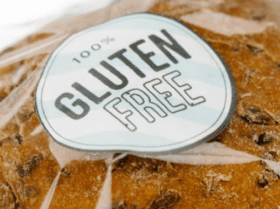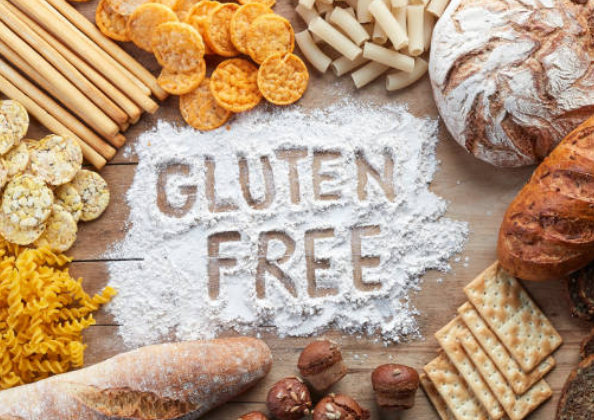When answering the question “what is gluten free bread” it is important to understand exactly what gluten is and how it’s properties effect your baking.
What exactly is gluten, and how does it form?
Glutenin and gliadin are two proteins found in wheat and other related cereals (such as barley and rye). The two proteins combine and produce gluten when flour derived from these grains is combined with water. Gluten does not develop in the absence of water.
Gluten proteins produce a sticky network with a glue-like consistency when flour is mixed with water. This glue-like quality gives bread its elasticity and allows it to rise during baking. It also has a nice chewy texture.
The more you stir the dough, the more gluten develops. As with bread dough, this enables the dough to become elastic and stretchy. The gluten is generated when the bread dough is kneaded. Kneading strengthens and lengthens the gluten strands.

The bread dough, on the other hand, does not stretch as easily if too much gluten is generated. The bread will become tough and chewy as a result of this. The elasticity of the dough is reduced when it is relaxed or rested, making it easier to roll out.
Wheat is by far the most common gluten-containing grain.
Is gluten bad for you?
In certain people, gluten can cause inflammatory, immunological, and autoimmune reactions.
A gluten-free diet helps patients with celiac disease avoid sickness and preserve better health. A gluten-free diet is absolutely necessary for them.
Then there are others who are labeled as “gluten-sensitive.” Despite the fact that their celiac disease tests are negative (normal), individuals experience symptoms (such as bloating, diarrhea, or crampy abdominal pain) when they consume gluten-containing meals.
There is very little evidence to support assertions that gluten has a detrimental impact on your health unless you have been diagnosed with celiac disease. Gluten is neither good nor bad (unless you have celiac disease).
 What is gluten free bread?
What is gluten free bread?
Gluten-free bread simply means any bread product that is free of wheat and other gluten-containing grains. It is beneficial to people who have celiac disease, gluten allergies, or gluten intolerances.
The following cereals cannot be used in gluten free products:
- Wheat (triticum aestivum or triticum durum) flour (white or wholemeal)
- Ancient wheats (einkorn, spelt, emmer, spelt, Kamut)
- Barley
- Rye
- Triticale
What is gluten free flour?
Gluten-free flours are prepared with various mixes, which varies greatly from one brand to the next. Rice flour, teff flour, tapioca flour, sorghum flour, potato starch, garbanzo flour, or buckwheat flour are just a handful of the many gluten-free flour possibilities.
Nut flours, formed from very finely ground almonds or other nuts, could also be found in these flours. Xanthan gum is a gluten-free flour binder that adds flexibility and makes the flour easy to use right out of the bag.
The top 5 gluten-free flours are: (what is gluten free bread)
Amaranth Flour — This sort of flour, which is technically a pseudocereal rather than a grain, has a nutty, earthy flavor and a tendency to absorb the flavor of other ingredients. It can be used to replace up to 25% of the wheat flour in a recipe, although it works best when combined with other flours.
Tapioca Flour — Tapioca flour is made from the starchy liquid derived from the cassava root. It has a mild flavor and mixes nicely with other gluten-free flours.
Almond Flour — Made completely of finely ground almonds, almond flour is a gluten-free flour that may be used in a variety of recipes. In most circumstances, it can be used in place of wheat flour in a 1:1 ratio, albeit you need add an extra egg and expect the final result to be a little denser.
Buckwheat Flour – This flour is made from a pseudocereal and has a deep, earthy flavor that complements bread beautifully. However, because it is crumbly, it is best used in conjunction with another gluten-free flour.
Cassava Flour — Of all the gluten-free flours, cassava flour is the most similar to wheat flour. It is made by shredding and drying the cassava root. It has a mild flavor, is easy to digest, and may be used in most recipes at a 1:1 ratio.
What is the difference between gluten free flour and wheat flour?
It is important to understand that there are some key differences in taste, texture, and appearance, between wheat flour and gluten free flour. Different types of gluten-free flour can generate extremely different outcomes in baked goods due to the base ingredients, giving a recipe an entirely different taste and texture.
Gluten-free breads do not rise as much as wheat-based loaves, which contributes to their light quality. Gluten-free loaves are typically made with heavier ingredients (this also contributes to the smaller size).
It’s possible that it won’t brown in the same way. A beautiful bake is defined by an evenly browned loaf, but gluten-free bread does not necessarily brown as evenly as wheat-based loaves. Brushing your gluten-free bread with milk or beaten egg before baking will help it color more evenly.
Keep in mind that gluten-free breads don’t have the same texture as wheat-based breads. Serving your breads and rolls warm can help improve the texture or toast your breads if they aren’t as soft or supple as you’d like.
Some gluten-free flours, particularly brown rice flour, have a slightly gritty feel. Corn flour, teff flour, and quinoa flours, on the other hand, are all a little gritty. For a finer texture, use less of these flours or grind them in a food processor.
If the texture of your gluten-free baked products isn’t quite right, put them in the freezer. Freezing helps to firm up the structure of the product and keeps it wet for longer.
How do I choose the right gluten free flour?
There are two ways to make gluten-free bread at home. Starting with a gluten-free bread recipe that uses one or more gluten-free flours is one option. Another option is to use an all-purpose gluten-free flour blend in place of wheat flour in your favorite wheat-based bread recipe. If you choose with this choice, there are a few features to look for in an all-purpose flour blend:
Avoid any blends that contain bean flours. These have a pungent flavor that can leave an unusual aftertaste. To conceal the flavor of the flour, you may need to add more sugar to the dough.
Use whole-grain flours whenever possible. Quinoa, amaranth, sorghum, and millet are examples of whole-grain flours with different flavors. If you like the flavor, go ahead and try it; otherwise, stick to milder selections.
Rice flour should not be the first ingredient in flour mixtures. Both white and brown rice flour have a gritty texture that doesn’t always bake up nicely, and the loaf is more likely to be dry and crumbly.
Look for things that have starches in them. Potato starch, cornstarch, arrowroot powder, and tapioca starch can all help to mitigate the grittiness of some gluten-free flours, resulting in a light and airy rather than dense and gritty final product.
If you are just starting to experiment with making gluten-free bread keep in mind that it’s possible that you’ll need to tweak your recipe and do some experimenting, but that’s half the joy of baking!
For some great gluten-free bread recipes head over to Gluten-Free Palate. She has some great ideas.

